|
North Carolina Civil War Battle
Civil War on the
North Carolina Coast
Battle
of South Mills
By
D. H. Hill, Jr.
| Civil War North Carolina Battle Map |
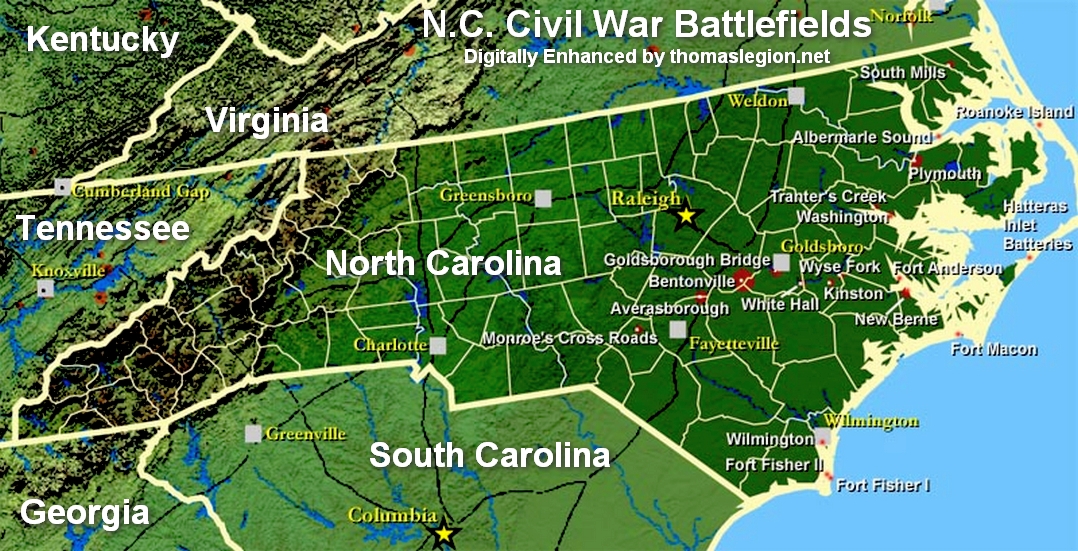
|
| North Carolina Civil War Battlefield Map |
| Battle of South Mills, North Carolina |
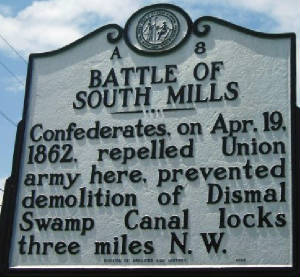
|
| (Historical Marker) |
History
On the 19th of April a spirited action
took place at South Mills, near the Dismal Swamp canal. Rumors of [Confederate] ironclads
building for a descent on the Albemarle fleet led the federals to send a considerable force, under General Reno, to destroy
the locks that connected both the Dismal Swamp canal and the Currituck canal with the rivers [1].
General Reno took with him from
New Bern [North Carolina] the Twenty-first Massachusetts, "500 picked men," and the Fifty-first Pennsylvania. On his
way, he way joined by Col. Rush Hawkins with his brigade, then stationed on Roanoke Island. Hawkins says that his force numbered
2,000 men. General Reno's whole command, including four pieces of artillery, numbered fully 3,000 men. This force was
landed from transports at Elizabeth City, and at once marched toward the locks. Near South Mills it encountered Col. A. R.
Wright, commanding the Third Georgia regiment (585 strong), some drafted North Carolina militia, Gillett's company of Southampton
cavalry; and McComas' battery of four pieces.
| Civil War Battle of South Mills, North Carolina |
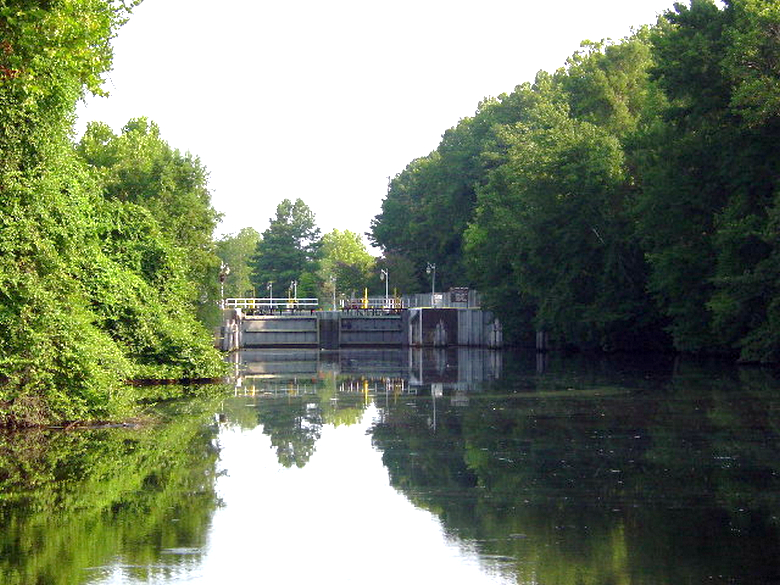
|
| Civil War on the NC Coast History |
| Battle of South Mills History and Map |
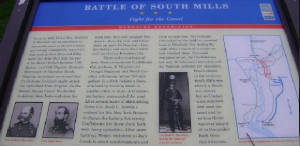
|
| South Mills Civil War History |
(Above) Great Dismal Swamp Canal Locks entrance to South Mills.
Wright's total force seems to have numbered about 750 men. Of these, he sent three companies and the militia
a mile to the rear to hold an important crossing. Stationing his artillery in the road and supporting it with his little force,
which General Huger say was not over 400 men, Wright pluckily waited for the attack of the enemy.
In spite of a long march, Reno, who had no idea of the small number of his foe, attacked promptly, but for
three hours made no impression on Wright's force, sheltered cleverly by the artillery and a strip of woods. At last, McComas,
who had fought his guns manfully, was killed, and Colonel Wright fell back a mile to his supports. General Reno did not attempt
to follow, and that night at 10 o'clock left his dead and wounded behind and made a forced march to his boats. The losses
of both sides were as follows: Confederate, killed, 6; wounded, 19. Federal, killed, 13; wounded, 92 [2].
| Battle of South Mills Map |
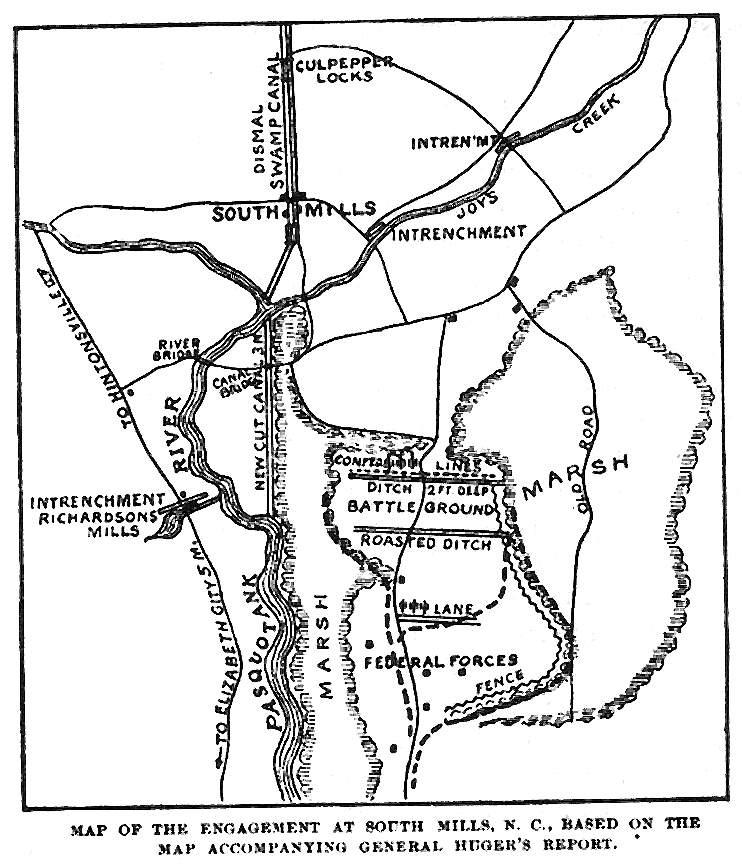
|
| Civil War on the North Carolina Coast |
| Dismal Swamp Canal |
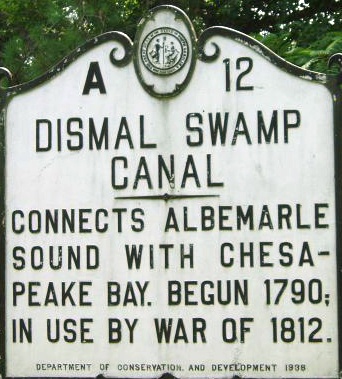
|
| (Historical Marker) |
[1] I have organized in conjunction with Commodore Rowan against that place
(Elizabeth City), and if we succeed in capturing or driving the enemy back, we shall move up to South Mills and blow up the
lock of the canal, and then proceed up to the head of Currituck canal and blow in its banks, thus rendering it impossible
for the gunboats, which are said to be building at Norfolk, to come into these waters. Official Records, page 271, Series
1, Vol. IX.
[2] An interesting difference between official and private reports comes
out in the Federal accounts of this battle. General Reno and his second in command, Colonel Hawkins, made such glowing reports
of what they had done that their commander, General Burnside (Burnside's North Carolina Expedition), issued a congratulatory order to their troops. In it he felicitates them "upon
the indomitable courage with which they attacked a large body of the enemy's best artillery, infantry and cavalry in their
own chosen position, achieving a complete victory." Official Records, IX, 307.
In a private letter to the same commander, the same General Hawkins says
in reference to the same affair: "Doubtless the unfortunate occurrence of the 19th has been brought to your notice. No one
can regret the result more than myself. First, because of the loss of life; second, the object of the expedition not being
accomplished after all the obstacles in our way had been removed. It seems that both parties were badly frightened. The enemy
ran like quarter-horses toward Norfolk, and we as fast as our weary legs would carry us toward Roanoke, leaving quite a number
of wounded, and destroyed the bridges behind us." Ibid., 316.
(Continued below)
Recommended Reading: Ironclads and Columbiads: The Coast (The Civil War in North Carolina)
(456 pages). Description: Ironclads and Columbiads
covers some of the most important battles and campaigns in the state. In January 1862, Union forces began in earnest to occupy
crucial points on the North Carolina coast. Within six months,
Union army and naval forces effectively controlled coastal North Carolina from the Virginia line south to present-day Morehead
City. Continued below...
Union setbacks in Virginia, however, led to the withdrawal of many federal soldiers from North Carolina,
leaving only enough Union troops to hold a few coastal strongholds—the vital ports and railroad junctions. The South
during the Civil War, moreover, hotly contested the North’s ability to maintain its grip on these key coastal strongholds.
Recommended Reading: Storm over Carolina: The Confederate
Navy's Struggle for Eastern North Carolina. Description: The struggle for control of the eastern waters of North Carolina during the War Between the States was a bitter, painful,
and sometimes humiliating one for the Confederate navy. No better example exists of the classic adage, "Too little, too late." Burdened
by the lack of adequate warships, construction facilities, and even ammunition, the South's naval arm fought bravely and even
recklessly to stem the tide of the Federal invasion of North Carolina from the raging Atlantic. Storm Over Carolina is the account of the
Southern navy's struggle in North Carolina waters and it
is a saga of crushing defeats interspersed with moments of brilliant and even spectacular victories. It is also the story
of dogged Southern determination and incredible perseverance in the face of overwhelming odds. Continued below...
For most of
the Civil War, the navigable portions of the Roanoke, Tar, Neuse, Chowan, and Pasquotank rivers were
occupied by Federal forces. The Albemarle and Pamlico sounds, as well as most of the coastal towns and counties, were also
under Union control. With the building of the river ironclads, the Confederate navy at last could strike a telling blow against
the invaders, but they were slowly overtaken by events elsewhere. With the war grinding to a close, the last Confederate vessel
in North Carolina waters was destroyed. William T. Sherman
was approaching from the south, Wilmington was lost, and the
Confederacy reeled as if from a mortal blow. For the Confederate navy, and even more so for the besieged citizens of eastern
North Carolina, these were stormy days indeed. Storm Over Carolina describes their story, their struggle, their history.
Recommended Reading:
Lifeline of the Confederacy: Blockade Running During
the Civil War (Studies in Maritime History Series).
From Library Journal: From the profusion of books about Confederate blockade running, this one will stand out for a long time
as the most complete and exhaustively researched. Though not unaware of the romantic aspects of his subject, Wise sets out
to provide a detailed study, giving particular attention to the blockade runners' effects on the Confederate war effort. Continued
below...
It was, he finds, tapping hitherto unused sources, absolutely essential, affording the South a virtual lifeline
of military necessities until the war's last days. This book covers it all: from cargoes to ship outfitting, from individuals
and companies to financing at both ends. An indispensable addition to Civil War literature.
Recommended Reading: Gray Raiders of the Sea: How Eight Confederate Warships Destroyed
the Union's High Seas Commerce. Reader’s Review: This subject is one
of the most fascinating in the history of sea power, and the general public has needed a reliable single-volume reference
on it for some time. The story of the eight Confederate privateers and their attempt to bring Union trade to a halt seems
to break every rule of common sense. How could so few be so successful against so many? The United
States, after Great Britain,
had the most valuable and extensive import/export trade in the world by the middle of the 19th century. The British themselves
were worried since they were in danger of being surpassed in the same manner that their own sea traders had surpassed the
Dutch early in the 18th century. Continued below…
From its founding
in 1861, the Confederate States of America realized it had a huge problem since it lacked a navy.
It also saw that it couldn't build one, especially after the fall of its biggest port, New
Orleans, in 1862. The vast majority of shipbuilders and men with maritime skills lived north of the
Mason-Dixon Line, in the United States, and mostly in New
England. This put an incredible burden on the Confederate Secretary of the Navy, Stephen R. Mallory. When he saw
that most of the enemy navy was being used to blockade the thousands of miles of Confederate coasts, however, he saw an opportunity
for the use of privateers. Mallory sent Archibald Bulloch, a Georgian and the future maternal grandfather of Theodore Roosevelt,
to England to purchase British-made vessels
that the Confederacy could send out to prey on Union merchant ships. Bulloch's long experience with the sea enabled him to
buy good ships, including the vessels that became the most feared of the Confederate privateers - the Alabama,
the Florida, and the Shenandoah. Matthew Fontaine Maury
added the British-built Georgia, and the Confederacy itself launched the
Sumter, the Nashville, the Tallahassee,
and the Chickamauga - though these were generally not as effective
commerce raiders as the first four. This popular history details the history of the eight vessels in question, and gives detailed
biographical information on their captains, officers, and crews. The author relates the careers of Raphael Semmes, John Newland
Maffitt, Charles Manigault Morris, James Iredell Waddell, Charles W. Read, and others with great enthusiasm. "Gray Raiders"
is a great basic introduction to the privateers of the Confederacy. More than eighty black and white illustrations help the
reader to visualize their dramatic exploits, and an appendix lists all the captured vessels. I highly recommend it to everyone
interested in the Confederacy, and also to all naval and military history lovers.
Recommended Reading: The Civil War in North Carolina.
Description: Numerous battles and skirmishes were fought in North Carolina during the Civil War, and the campaigns and battles themselves were crucial
in the grand strategy of the conflict and involved some of the most famous generals of the war. John Barrett presents the
complete story of military engagements across the state, including the classical pitched battle of Bentonville--involving
Generals Joe Johnston and William Sherman--the siege of Fort
Fisher, the amphibious campaigns on the coast, and cavalry sweeps such
as General George Stoneman's Raid.
Recommended Reading: The Civil War in the Carolinas (Hardcover). Description: Dan Morrill relates the experience of two quite different states bound together in
the defense of the Confederacy, using letters, diaries, memoirs, and reports. He shows
how the innovative operations of the Union army and navy along the coast and in the bays and rivers of the Carolinas
affected the general course of the war as well as the daily lives of all Carolinians. He demonstrates the "total war" for
North Carolina's vital coastal railroads and ports. In
the latter part of the war, he describes how Sherman's operation
cut out the heart of the last stronghold of the South. Continued below...
The author
offers fascinating sketches of major and minor personalities, including the new president and state governors, Generals Lee,
Beauregard, Pickett, Sherman, D.H. Hill, and Joseph E. Johnston. Rebels and abolitionists, pacifists and unionists, slaves
and freed men and women, all influential, all placed in their context with clear-eyed precision. If he were wielding a needle
instead of a pen, his tapestry would offer us a complete picture of a people at war. Midwest Book Review: The Civil War in the Carolinas by civil war expert and historian Dan
Morrill (History Department, University of North Carolina at Charlotte, and Director of the Charlotte-Mecklenburg Historical
Society) is a dramatically presented and extensively researched survey and analysis of the impact the American Civil War had
upon the states of North Carolina and South Carolina, and the people who called these states their home. A meticulous, scholarly,
and thoroughly engaging examination of the details of history and the sweeping change that the war wrought for everyone, The
Civil War In The Carolinas is a welcome and informative addition to American Civil War Studies reference collections.
Recommended Reading: The Flags of Civil War North
Carolina. Description: Compiled and written by educator and Civil War expert Glenn Dedmondt, The Flags Of Civil War North Carolina
is a very straightforward reference presenting photographs, color illustrations, descriptions and history of the titular flags
that flew over North Carolina when it seceded from the Union.
Each page or two-page spread features the different flags of the various North Carolina
regiments. A meticulously detailed resource offering very specific information for history and civil war buffs, The Flags
Of Civil War North Carolina is a welcome contribution to the growing library of Civil War Studies and could well serve as
a template for similar volumes for the other Confederate as well as Union states. Great photos and illustrations! Continued
below...
Flags stir powerful emotions,
and few objects evoke such a sense of duty and love for the homeland. In April 1861, the first flag of a new republic flew
over North
Carolina. The state had just seceded from the union, and its citizens would soon have to fight for
their homes, their families, and their way of life. Each flag is meticulously detailed and scaled to perfection. The Flags
of Civil War North Carolina is the history of this short-lived
republic (which later joined the Confederacy), told through the banners that flew over its government, cavalry, and navy.
From the hand-painted flag of the Guilford Greys to the flag of the Buncombe Riflemen--made from the dresses
of the ladies of Asheville--this collection is an exceptional
tribute to the valiant men who bore these banners and to their ill-fated crusade for independence. About
the Author: Glenn Dedmondt, a lifelong resident of the Carolinas and member of the Sons of Confederate Veterans, shares
his passion for the past as a teacher of South Carolina
history. Dedmondt has also been published in Confederate Veteran magazine.
|

